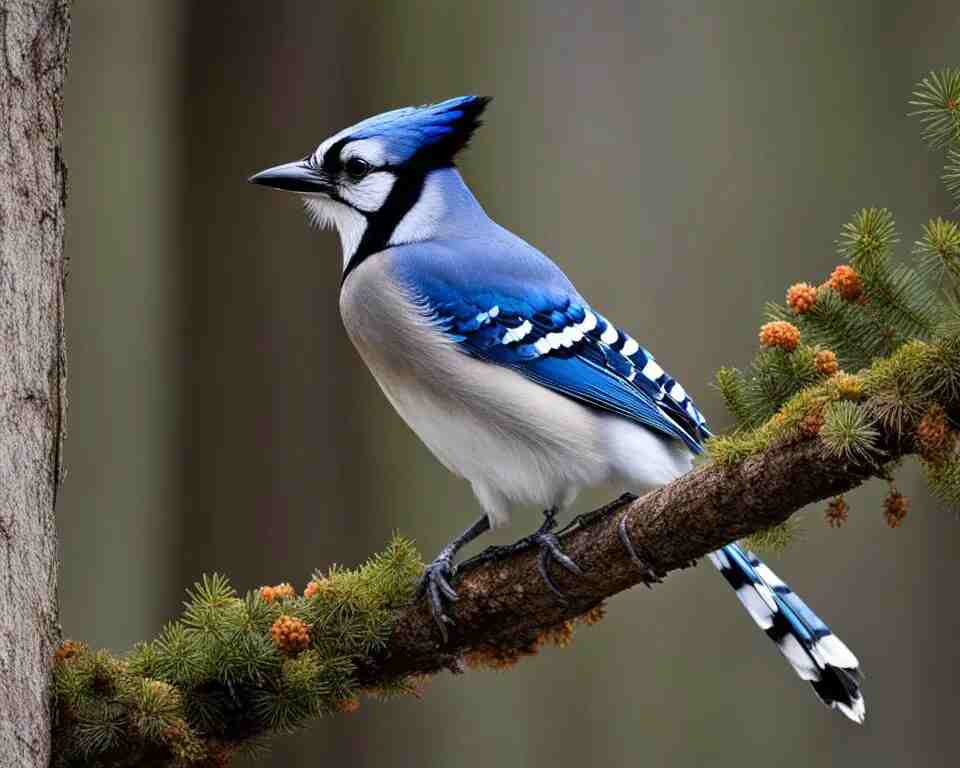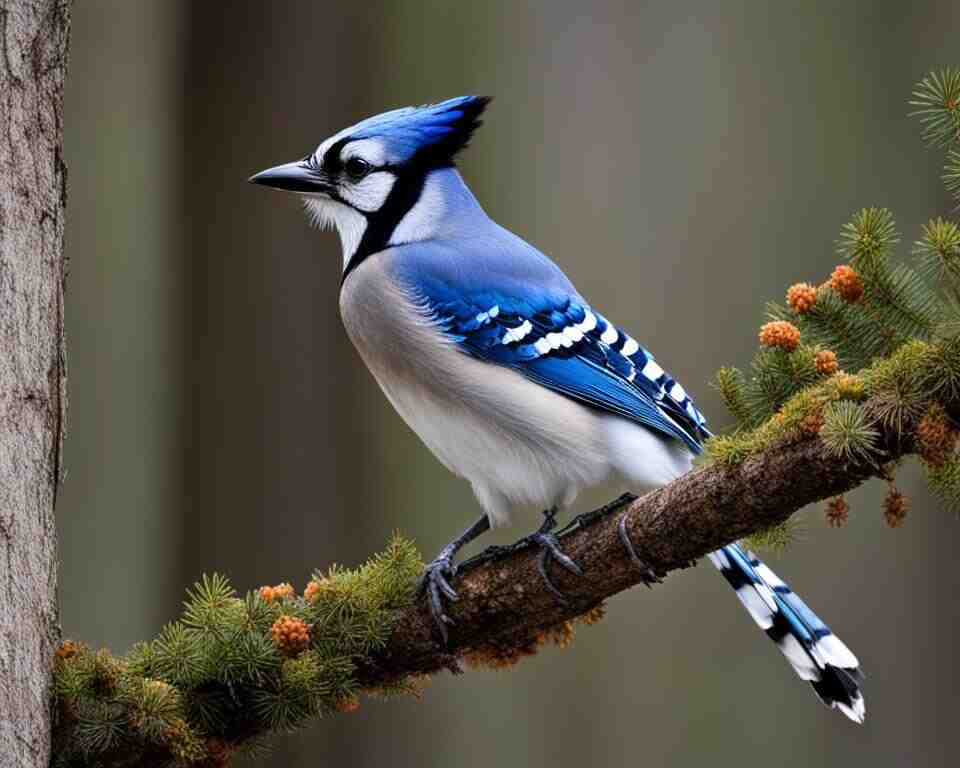Blue jays have gained a reputation for being mean birds due to their aggressive behavior. However, it is important to understand their behavior before drawing conclusions.
This article will explore the reasons behind blue jays’ intimidating tactics and compare them to other bird species.
Table of Contents
- 1 Key Takeaways:
- 2 Are Blue Jays Mean Birds?
- 3 Exploring the Aggressive Behavior of Blue Jays
- 4 Unveiling the Truth: Are Blue Jays Mean Birds?
- 5 Characteristics and Intelligence of Blue Jays
- 6 Understanding Blue Jays’ Territorial Nature
- 7 The Blue Jay’s Diet: Insight Into Their Feeding Habits
- 8 Attracting Blue Jays: Creating a Bird-Friendly Environment
- 9 Conclusion
- 10 FAQs:
- 10.1 What are some documented cases of blue jays’ aggression?
- 10.2 What are the possible reasons behind blue jays’ intimidating tactics?
- 10.3 What are the characteristics and intelligence of blue jays?
- 10.4 Do blue jays have territorial behavior?
- 10.5 How do blue jays protect their nest and young?
- 10.6 What is the diet of blue jays?
- 10.7 How can I attract blue jays to my garden?
- 10.8 What is the myth about blue jays and their behavior?
- 11 Source Links
- 12 Author
Key Takeaways:
- Blue jays are known for their aggressive behavior, leading to their reputation as mean birds.
- Understanding their behavior is crucial in dispelling myths and misconceptions about blue jays.
- Comparing blue jays’ behavior to that of other bird species can provide valuable insights.
- Exploring the possible reasons behind their aggressive tactics can offer a deeper understanding of their behavior.
- Appreciating the complexity of blue jay behavior is essential for conservation and coexistence.

Are Blue Jays Mean Birds?
Blue Jays are often perceived as aggressive due to their territorial behavior, especially during nesting. While they may defend their territory vigorously, it’s essential to note that this behavior doesn’t necessarily make them “mean.”
Blue Jays are intelligent, adaptable birds known for their striking appearance and resourcefulness in various environments. Understanding their behavior helps foster coexistence.
Exploring the Aggressive Behavior of Blue Jays
Blue Jays have gained notoriety for their aggressive behavior, displaying intimidating tactics in various situations. This section aims to delve deeper into their aggression, documenting cases of blue jays’ aggressive behavior and exploring the possible reasons behind their intimidating tactics.
Additionally, we will compare their aggression to that of other bird species, shedding light on the unique aspects of blue jay aggression.
Documented Cases of Blue Jays’ Aggression
Blue jays have been observed engaging in aggressive acts, including raiding nests and even decapitating other birds. These documented cases provide insights into the extent and severity of their aggressive behavior, allowing us to understand the scope of their actions.
The Possible Reasons Behind Their Intimidating Tactics
Understanding the underlying reasons for blue jays’ aggressive behavior is crucial in gaining a comprehensive view of their actions. We will explore potential factors, such as territorial protection, competition for resources, and defense of their young, that may drive the blue jays’ intimidating tactics. By examining these possible reasons, we can unravel the motivations behind their aggressive behavior.
Comparative Aggression: Blue Jays Vs. Other Bird Species
To better understand the nuances of blue jay aggression, it is important to compare their behavior to that of other bird species. By examining different bird species’ aggression, we can gain insight into the variations in aggressive behaviors across avian populations. This comparative analysis will contribute to a more comprehensive understanding of the unique aspects of blue jay aggression.
Unveiling the Truth: Are Blue Jays Mean Birds?
Despite their reputation, it is essential to determine whether blue jays are truly mean birds or if their behavior is misunderstood. In order to shed light on this topic, we will carefully examine different aspects of blue jay behavior.
Firstly, it’s important to note that blue jays can exhibit aggressive behavior towards other birds, especially during nesting season. This aggression is often directed towards potential threats to their nests and young. However, it is crucial to understand that this behavior is driven by their instinct to protect their offspring rather than a genuinely mean-spirited nature.
Blue jays also display territoriality, fiercely guarding their territory from intruders. This territorial behavior, although intimidating, is a common characteristic among many bird species and serves as a means of establishing and protecting resources.
Furthermore, blue jays are highly intelligent and adaptable birds. They possess excellent problem-solving skills, which they utilize when foraging for food and storing it for future use. Their cognitive abilities contribute to their survival and success in diverse environments.
It is worth noting that blue jays play significant ecological roles. They assist in seed dispersal and contribute to forest regeneration. Their presence in ecosystems brings about a balance by regulating populations of insects and small vertebrates.
By understanding the complexities of blue jay behavior and the factors that influence their actions, we can appreciate their true nature beyond the simplistic label of being mean birds. It is crucial to approach the topic with an open mind and consider the larger context in which they exist.

| Blue Jay Behavior Traits | Meaning |
|---|---|
| Aggressive behavior towards other birds | Critical for protecting nests and offspring |
| Territorial behavior | Ensures access to resources |
| Intelligent and adaptable | Utilize problem-solving skills for survival |
| Ecosystem role | Aid in seed dispersal and population control |
Characteristics and Intelligence of Blue Jays
Understanding the characteristics and intelligence of blue jays is crucial in comprehending their behavior. Blue jays exhibit unique physical attributes, cognitive abilities, and behaviors that set them apart from other bird species.
Blue jays are medium-sized birds, typically measuring 9-12 inches in length, with a wingspan of 13-17 inches. They have striking blue feathers on their upper body, a crest on their head, and black markings around their neck and face. The vibrant blue coloration not only makes them visually appealing but also helps them blend in with the foliage.
Blue jays possess remarkable intelligence and have been deemed one of the most intelligent bird species. They have the ability to mimic calls of other birds, produce a wide range of vocalizations, and even imitate human speech to some extent. Their cognitive abilities enable them to solve complex problems, remember locations of food caches, and adapt to various environments.
One notable behavior of blue jays is their cache management strategy. Blue jays store excess food, such as acorns, in hidden locations called caches. They have the ability to remember the exact locations of their caches, even when covered in snow or foliage. This demonstrates their exceptional memory and planning skills.
Furthermore, blue jays are known for their curious and resourceful nature. They actively investigate their surroundings, often engaging in exploratory behavior to find food and nesting materials. This adaptability allows them to thrive in diverse habitats, including forests, woodlands, parks, and even suburban areas.
| Characteristics | Intelligence | Behavior |
|---|---|---|
| Vibrant blue feathers | Mimicry of calls | Cache management |
| Distinct crest | Complex problem-solving | Curiosity and resourcefulness |
| Black markings | Vocalization versatility | Adaptability to different environments |
Understanding Blue Jays’ Territorial Nature
Blue jays are well-known for their territorial behavior, fiercely defending their territory from intruders. This territorial nature plays a significant role in shaping their behavior and interactions with other birds. Let’s explore the intricacies of blue jays’ territoriality and how it influences their nesting habits and responses to territory invasion.
The Role of Territoriality in Blue Jays’ Behavior
Territoriality is a common behavior exhibited by many bird species, and blue jays are no exception. By establishing and defending their territory, blue jays ensure they have sufficient resources and breeding opportunities. Their territorial behavior serves as a means of maintaining access to food sources, nesting sites, and mates.
Blue jays actively communicate their territorial boundaries through vocalizations, visual displays, and aggressive behaviors. They establish their territory during the breeding season and vigorously defend it from intruders, including other blue jays and even larger birds. This territorial defense mechanism is crucial for the successful reproduction and survival of their offspring.
How Blue Jays Protect Their Nest and Young
Blue jays are meticulous nest builders and invest a great deal of effort in constructing secure nests for their young. They typically build their nests in the forks of trees, often high above the ground, providing protection from predators. The nesting habits of blue jays further reinforce their territorial nature as they select nesting sites within their established territory.
When it comes to protecting their nest and young, blue jays display fierce aggression towards potential threats. They will actively defend their nests against predators, including squirrels, snakes, and other birds. Blue jays may use their sharp beaks and powerful wings to deter intruders and ward them off from their nesting area.
Recognizing Territory Invasion: Blue Jays’ Responses
Blue jays have distinct responses to territory invasion, quickly identifying and responding to potential threats. When a blue jay detects an intruder encroaching on its territory, it will engage in alarm calls, loud vocalizations that serve as warnings to other blue jays in the area. These alarm calls rally neighboring blue jays, reinforcing the defense of the territory.
In addition to vocalizations, blue jays may engage in aggressive behaviors when defending their territory. They may chase and harass intruders, engaging in aerial pursuits and physical confrontations to protect their territory. These territorial disputes can be intense and can sometimes result in injuries to both parties involved.
Understanding blue jays’ territorial nature and their responses to territory invasion provides valuable insights into their behavior. It highlights the importance of respecting their boundaries and allowing them to thrive in their natural habitats.

| Blue Jays’ Territory Defense | Characteristics |
|---|---|
| Establishment of territory | Blue jays actively establish and defend their territory. |
| Communication | Vocalizations and visual displays are used to communicate territorial boundaries. |
| Nest protection | Blue jays fiercely defend their nests from potential predators. |
| Responses to invasion | Blue jays respond to territory invasion with alarm calls and aggressive behaviors. |
The Blue Jay’s Diet: Insight Into Their Feeding Habits
Understanding the diet of blue jays is crucial in understanding their behavior. Blue jays have a diverse diet that includes a wide range of food items, from acorns to small vertebrates. Their feeding habits are fascinating and reflect their adaptable nature.
A Diverse Diet: From Acorns to Small Vertebrates
Blue jays are opportunistic omnivores, meaning they consume both plant and animal matter. Their diet consists of various seeds, nuts, berries, fruits, insects, and even small vertebrates such as frogs and small birds. This diverse range of food sources allows blue jays to adapt to different environments and seasons.
Foraging Techniques and Storage Strategies
Blue jays employ various foraging techniques to obtain their food. They use their strong beaks to crack open nuts and acorns, and they have been observed burying food for later consumption. This behavior, known as caching, helps them build up food reserves during periods of abundance and allows them to survive when food is scarce.
When caching food, blue jays have excellent spatial memory and can remember the locations of hundreds of caches. This ability is essential for their survival, as they rely on stored food during winter months or when natural food sources are limited.
The Impact of Blue Jays’ Diet on Their Behavior
The diet of blue jays plays a significant role in shaping their behavior. Their opportunistic feeding habits and ability to consume a wide range of food sources make them adaptable and resourceful birds.
Blue jays’ foraging behavior also has ecological implications. They play an important role in seed dispersal, as they consume fruits and nuts and then spread the seeds through their droppings. This contributes to the regeneration of plant species and helps maintain biodiversity in their habitats.
| Food Items | Examples |
|---|---|
| Seeds and Nuts | Acorns, sunflower seeds, beechnuts |
| Berries and Fruits | Blackberries, cherries, grapes |
| Insects | Caterpillars, grasshoppers, beetles |
| Small Vertebrates | Frogs, small birds, mice |
Attracting Blue Jays: Creating a Bird-Friendly Environment
If you want to attract blue jays to your garden or backyard, creating a bird-friendly environment is essential. Blue jays are beautiful and intelligent birds known for their striking blue feathers and distinctive crests. By providing them with the right conditions and resources, you can encourage blue jays to visit and even nest in your area.
One way to attract blue jays is by offering a variety of food sources. These birds have diverse diets, so providing a mix of seeds, nuts, fruits, and insects will cater to their preferences. Consider setting up bird feeders specifically designed for blue jays, with perches and trays that can accommodate their size and feeding style.
Creating natural habitats is another effective way to attract blue jays. Planting native trees and shrubs that produce berries, acorns, or other fruits will not only provide food but also offer suitable nesting sites and shelter. Blue jays are known to prefer forested areas, so incorporating vegetation that replicates their natural habitat will be highly enticing to them.
Water features are also attractive to blue jays. Install a bird bath or shallow water dish that allows them to drink, bathe, and cool off. Make sure to keep the water clean and refreshed regularly to maintain a healthy environment.
Create a bird-friendly environment by minimizing the use of pesticides and chemicals in your garden. These substances can be harmful to birds and their food sources, affecting their overall well-being. Instead, opt for natural alternatives and organic gardening practices to ensure a safe and healthy ecosystem.
In urban areas, blue jays may face various challenges due to limited green spaces and increased human activity. However, you can still attract them by providing bird houses or nesting boxes specifically designed for blue jays. These structures mimic natural tree cavities and offer them a safe place to build their nests and raise their young.
To maximize the chances of attracting blue jays, place feeders, bird baths, and nesting structures in visible and easily accessible locations. Ensure the area is quiet, free from sudden movements, and protected from potential predators to create a safe and inviting space.
Remember to be patient, as attracting blue jays may take time. Providing a bird-friendly environment not only benefits blue jays but also promotes biodiversity and the well-being of other bird species. Enjoy the beauty and presence of these magnificent birds as they grace your backyard with their vibrant colors and lively personalities.
Conclusion
In conclusion, it is important to address the myth surrounding blue jays’ misunderstood behavior. While they have gained a reputation for being mean birds, it is crucial to understand and appreciate the complexity of their behavior. Blue jays exhibit aggressive tendencies due to their territorial nature, which is a natural instinct for survival and reproductive success.
By recognizing and respecting their territorial boundaries, we can coexist harmoniously with these fascinating birds. Conservation efforts play a vital role in protecting blue jays and ensuring their continued presence in our environment. Their presence is not only visually appealing but also contributes to the overall health and balance of ecosystems.
In our efforts to conserve and coexist with blue jays, creating a bird-friendly environment is essential. By providing food sources, water, and suitable nesting sites, we can attract blue jays and other bird species to our gardens or backyards. This not only benefits the birds but also enriches our own lives as we connect with nature and appreciate the beauty and diversity it offers.
In conclusion, let us dispel the myth of blue jays as mean birds and embrace the opportunity to understand, appreciate, and coexist with these remarkable creatures. By fostering a sense of conservation and respect for their behavior, we can build a future where blue jays thrive alongside us, enriching our lives with their presence and reminding us of the importance of coexisting with nature.
FAQs:
What are some documented cases of blue jays’ aggression?
Documented cases include raiding nests and even decapitating other birds.
What are the possible reasons behind blue jays’ intimidating tactics?
This section will delve into the possible reasons behind their aggression and compare their behavior to that of other bird species.
What are the characteristics and intelligence of blue jays?
Understanding the physical attributes, cognitive abilities, and behaviors of blue jays is crucial in comprehending their behavior.
Do blue jays have territorial behavior?
Yes, blue jays are known for their territorial nature and their aggressive defense of their territory.
How do blue jays protect their nest and young?
This section will delve into the role of territoriality in blue jays’ behavior, how they protect their nest and young, and how they respond to territory invasion.
What is the diet of blue jays?
Blue jays have a diverse diet, including acorns, small vertebrates, and other food sources. This section will explore their feeding habits and storage strategies.
How can I attract blue jays to my garden?
Creating a bird-friendly environment is essential to attract blue jays and other bird species. This section will provide tips and advice on how to create an environment that will benefit them.
What is the myth about blue jays and their behavior?
This section will address the myth of blue jays as mean birds and emphasize the importance of understanding and appreciating the complexity of their behavior.


